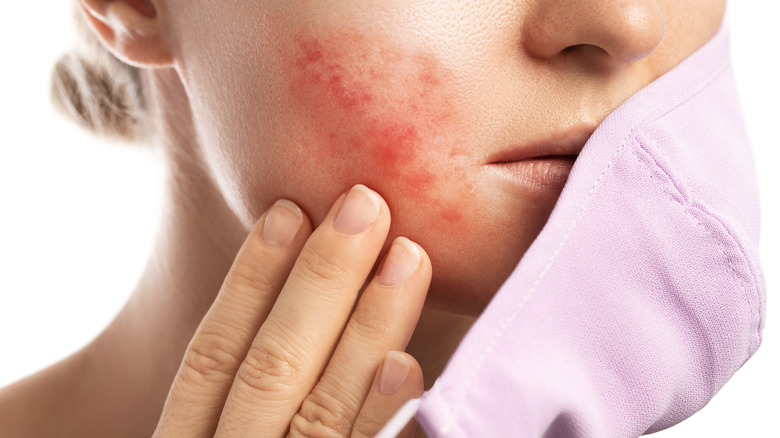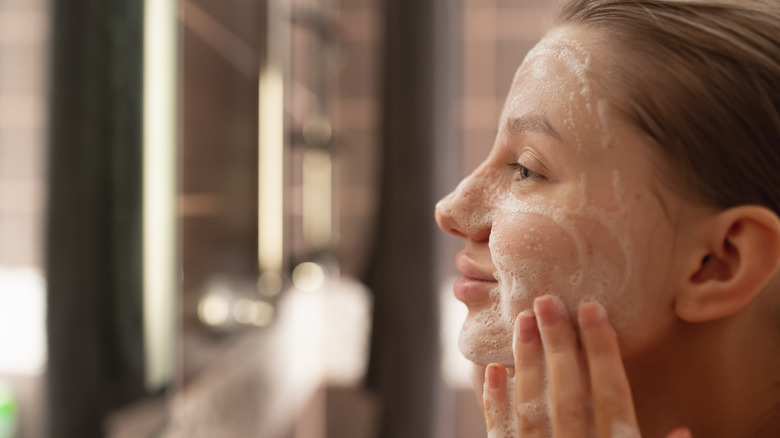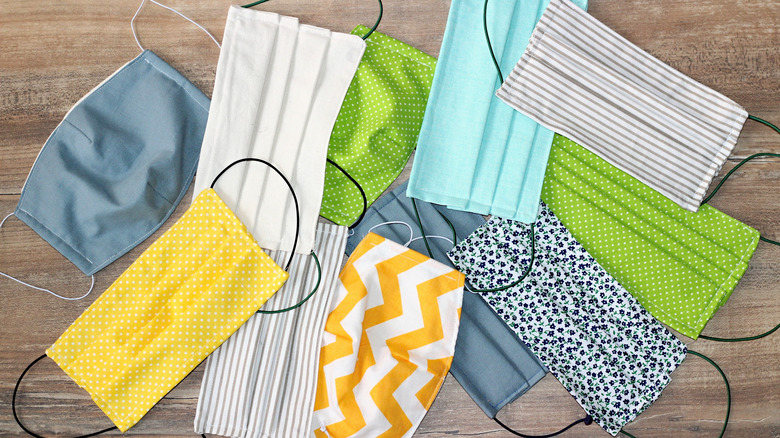A Dermatologist's Advice For How To Treat Maskne
Wondering how to treat maskne and restore your complexion? First, make sure you understand what's causing this problem. The term "maskne" was coined during the novel coronavirus crisis to describe a form of acne associated with masks and other facial coverings. Formally known as acne mechanica, this condition is due to the friction between fabric and skin, according to 2021 research published in the International Journal of Dermatology. There's no doubt that face masks can limit the risk of contracting COVID-19, but they can also alter the skin microbiota and increase sweating. These factors may lead to eczema flare-ups, fungal infections, rashes, itching, and acne breakouts.
Acne mechanica can affect any part of the body — not just your face and neck. For example, people who wear compression shirts may experience breakouts on their backs. "I see it a lot with patients where a tighter sports bra or tighter clothing and athletic wear can compress that skin on the back and [make] it easier for acne to erupt right there," said dermatologist Aaron Secrest in an interview with Today. What's more, certain foods — especially those rich in simple carbs — may worsen acne. Genetics, stress, and sun exposure play a role, too.
Face masks can also exacerbate rosacea and other pre-existing conditions, reports a 2021 study featured in Dermatologic Therapy. Papules, pustules, and excess sebum production are common among those who wear masks regularly. On the positive side, it's possible to prevent or reduce maskne by tweaking your skincare routine.
Cleanse and moisturize your skin to prevent maskne
Masks increase sweating and cause your skin to retain sweat, leading to bacterial growth. At the same time, they alter the skin's pH and disrupt the balance of good and bad bacteria, explains a 2022 review published in the Journal of Clinical Medicine. Debris and makeup residue can further affect your skin, leading to clogged pores. These factors combined may trigger or worsen acne and other dermatological disorders.
While it's not possible to completely eliminate these problems, you can minimize their impact on your skin. For starters, remember to wash your hands when handling the mask. Also, consider using a cleanser with antibacterial ingredients and a pH of 5 to 7.3. The American Academy of Dermatology Association (AAD) recommends cleansing your face every day.
Apply the cleanser, rinse your water, and pat dry with a napkin or towel. When you're done, apply a moisturizer with ceramides, dimethicone, or hyaluronic acid. Ideally, look for products that match your skin type. Moisturizing creams work best for dry skin, while gel moisturizers are suitable for acne-prone or oily skin, says the AAD. Experts also recommend either skipping the makeup or using non-comedogenic makeup when you wear a mask. These measures can help prevent your pores from clogging and hence reduce acne breakouts.
Choose your face mask wisely
Each type of fabric has a different impact on the skin. If you're prone to acne, be sure to choose the best face mask for your skin. Masks made of natural fibers like cotton or lyocell are more effective at absorbing moisture than their synthetic counterparts. As a result, they may reduce microbial growth and prevent breakouts (via the International Journal of Dermatology). N95 respirators are the most likely to cause acne, whereas surgical and cloth masks have the least impact on the skin, reports a 2021 study featured in Clinical, Cosmetic and Investigational Dermatology.
Note that dark colors promote heat retention, so it's best to wear a light-colored mask. Select one with a smooth surface or expandable folds to reduce the friction between skin and textiles. Remember to change it regularly to prevent bacterial growth. If you wear reusable masks, wash them with a fragrance-free detergent after each use, per Atrium Health. As a rule of thumb, take your mask off for about 15 minutes every few hours.
If your symptoms persist, you may need to use topical products with benzoyl peroxide, retinoids, antibiotics, azelaic acid, or salicylic acid (per the Journal of Clinical Medicine). For example, benzoyl peroxide may protect against irritation and reduce bacterial growth, while topical retinoids are effective against inflammation and blemishes. In more severe cases, your dermatologist may prescribe oral antibiotics, such as doxycycline or tetracycline, to treat maskne.


